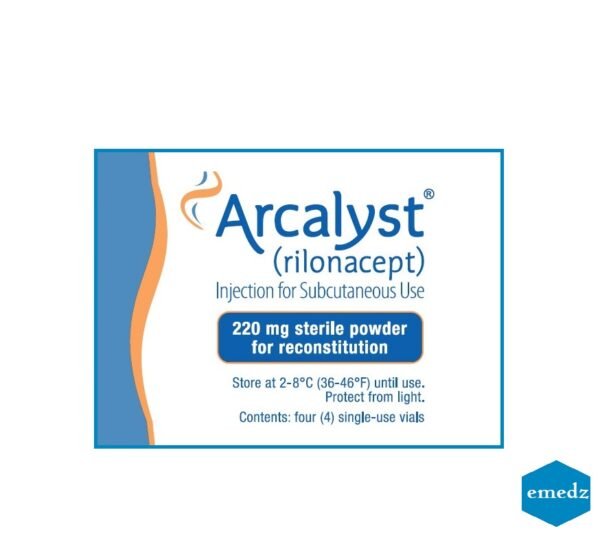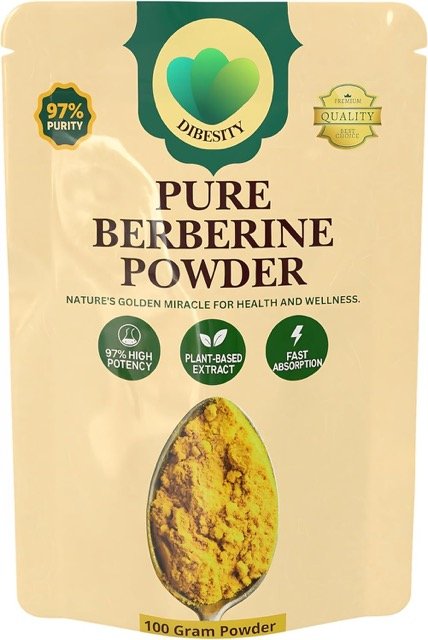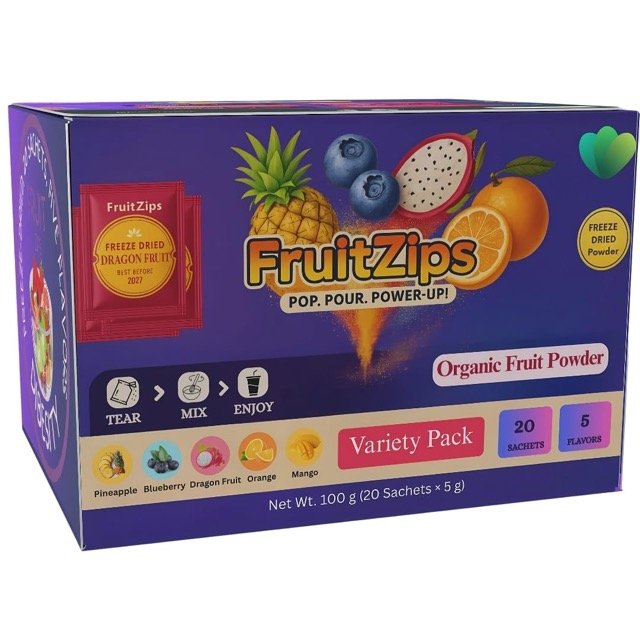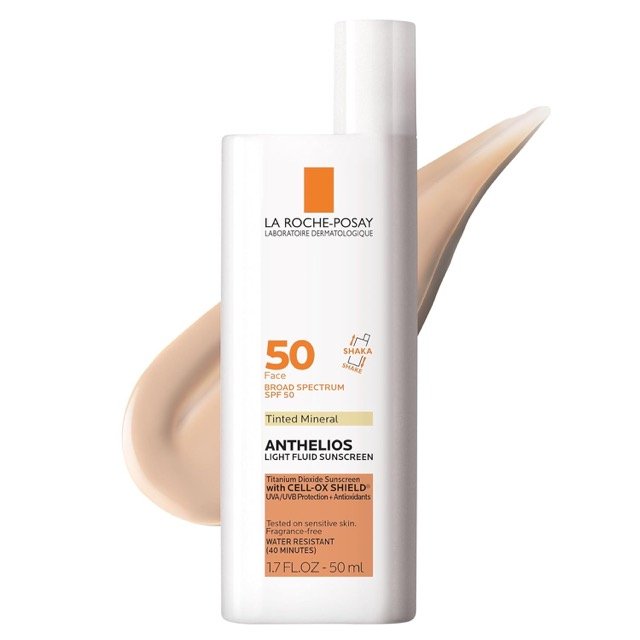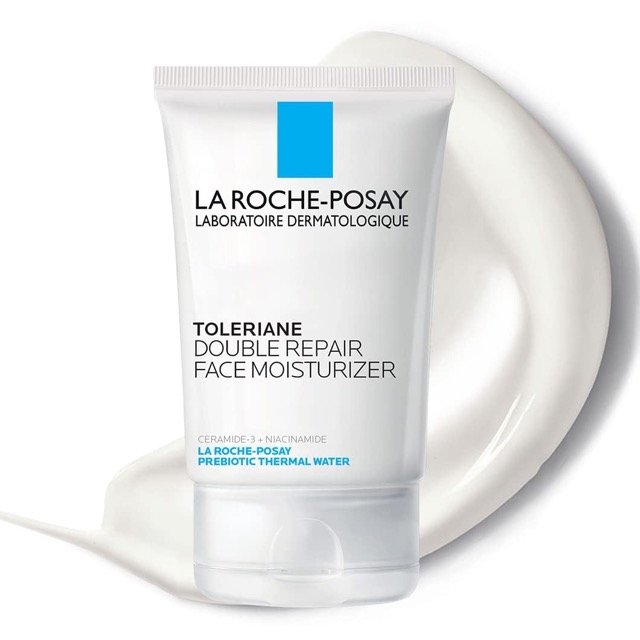Rilonacept is a medication used to treat certain inflammatory conditions. It belongs to a class of drugs known as interleukin-1 (IL-1) inhibitors. IL-1 is a protein in the body that plays a role in inflammation and immune responses. By inhibiting IL-1, rilonacept helps to reduce inflammation and symptoms associated with conditions such as cryopyrin-associated periodic syndromes (CAPS), including familial cold autoinflammatory syndrome and Muckle-Wells syndrome. Rilonacept is typically administered by injection under the skin (subcutaneously).
Rilonacept (Arcalyst) inhibits inflammation by binding to Interleukin 1B receptors in patients with Cryopyrin-associated periodic syndromes (CAPS) which is a rare hereditary inflammatory condition.
Rilonacept Uses:
- Cryopyrin-associated periodic syndromes:
- It is indicated for the treatment of cryopyrin-associated periodic syndromes in adults and children older than 12 years of age.
- These include:
- Familial cold autoinflammatory syndrome
- Muckle-Wells syndrome.
- Neonatal-onset multisystem inflammatory disease (NOMID).
Rilonacept (Arcalyst) Dose in Adults
Rilonacept (Arcalyst) Dose in the treatment of Cryopyrin-associated periodic syndromes: SubQ:
Starting Dose:
- You'll get a total of 320 mg of Rilonacept.
- This is given as 2 separate injections, each containing 160 mg (2 mL) of the medication.
- Both injections are given on the same day but at different spots on your body.
Maintenance Dose:
- After the initial dose, you'll switch to a maintenance dose.
- This is 160 mg given once a week.
- Start the maintenance dose one week after the initial loading dose.
- Don't take it more often than once a week.
Rilonacept (Arcalyst) Dose in Children
Rilonacept (Arcalyst) Dose in the treatment of Cryopyrin-associated periodic syndromes (CAPS):
For Children (12 to 17 years old):
- Initial Dose:
- A loading dose of 4.4 mg/kg, up to a maximum of 320 mg per dose.
- The loading dose can be given in 1 or 2 separate injections on the same day, at different spots.
- Maintenance Dose:
- Start one week after the loading dose.
- It's 2.2 mg/kg per dose, up to a maximum of 160 mg per dose.
- Don't take it more often than once a week.
For Adolescents (18 years and older):
- Initial Dose:
- A loading dose of 320 mg, given as 2 separate injections (160 mg each) on the same day, at different spots.
- Maintenance Dose:
- Start one week after the loading dose.
- It's 160 mg once weekly.
- Don't take it more often than once a week.
Pregnancy Risk Factor C
- When it comes to pregnancy, Rilonacept falls into category C, meaning there have been adverse effects noted in animal studies related to reproduction.
Use during breastfeeding:
- It's uncertain whether rilonacept passes into breast milk.
- Because of this uncertainty, caution is advised when giving rilonacept to nursing mothers, according to the manufacturer's recommendation.
Dose in Kidney Disease:
- The manufacturer's instructions don't include any specific adjustments in dosage for people with kidney problems because this aspect hasn't been studied.
Dose in Liver disease:
- The manufacturer's instructions don't offer any dosage changes for individuals with liver issues because this aspect hasn't been thoroughly studied.
Common Side Effects of Rilonacept (Arcalyst):
- Immunologic:
- Antibody Development
- Infection:
- Increased Susceptibility To Infection
- Local:
- Injection Site Reaction
- Respiratory:
- Upper Respiratory Tract Infection
Less Common Side Effects of Rilonacept (Arcalyst):
- Central Nervous System:
- Hypoesthesia
- Respiratory:
- Cough
- Sinusitis
Contraindication to Rilonacept (Arcalyst):
- According to the manufacturer's instructions, there are no specific situations where the use of rilonacept is prohibited.
Warnings and precautions
Anaphylaxis or hypersensitivity reactions
- Although rare, rilonacept can sometimes lead to severe allergic reactions known as anaphylaxis or hypersensitivity reactions.
- If you experience such a reaction, it's essential to stop using rilonacept and seek appropriate medical treatment right away.
Infections
- Before using rilonacept, it's important to be cautious if you have a history of infections or conditions that make you prone to infections.
- If you develop a new infection while using rilonacept, it's crucial to be closely monitored.
- If the infection becomes severe, treatment with rilonacept should be stopped.
- Rilonacept should not be started if you have an active or chronic infection.
- Additionally, there's a risk of latent tuberculosis reactivating, so it's necessary to follow current guidelines for evaluating and treating latent tuberculosis before starting rilonacept therapy.
Malignancy
- Using rilonacept might weaken your body's ability to defend against cancer.
- However, how it affects the development and progression of cancer is not entirely understood yet.
Hyperlipidemia:
- Taking rilonacept might lead to higher levels of cholesterol, both the good (HDL) and bad (LDL) kinds, as well as triglycerides.
- It's important to regularly check your lipid profile while using rilonacept.
- In some cases, starting medication to lower cholesterol levels may be needed.
Rilonacept: Drug Interaction
|
Coccidioides immitis Skin Test |
Immunosuppressants may diminish the diagnostic effect of Coccidioides immitis Skin Test. |
|
Denosumab |
May enhance the adverse/toxic effect of Immunosuppressants. Specifically, the risk for serious infections may be increased. |
|
Ocrelizumab |
May enhance the immunosuppressive effect of Immunosuppressants. |
|
Pidotimod |
Immunosuppressants may diminish the therapeutic effect of Pidotimod. |
|
Siponimod |
Immunosuppressants may enhance the immunosuppressive effect of Siponimod. |
|
Tertomotide |
Immunosuppressants may diminish the therapeutic effect of Tertomotide. |
|
Trastuzumab |
May enhance the neutropenic effect of Immunosuppressants. |
|
Risk Factor D (Consider therapy modification) |
|
|
Baricitinib |
Immunosuppressants may enhance the immunosuppressive effect of Baricitinib. Management: Use of baricitinib in combination with potent immunosuppressants such as azathioprine or cyclosporine is not recommended. Concurrent use with antirheumatic doses of methotrexate or nonbiologic disease modifying antirheumatic drugs (DMARDs) is permitted. |
|
Echinacea |
|
|
Fingolimod |
Immunosuppressants may enhance the immunosuppressive effect of Fingolimod. Management: Avoid the concomitant use of fingolimod and other immunosuppressants when possible. If combined, monitor patients closely for additive immunosuppressant effects (eg, infections). |
|
Leflunomide |
Immunosuppressants may enhance the adverse/toxic effect of Leflunomide. Specifically, the risk for hematologic toxicity such as pancytopenia, agranulocytosis, and/or thrombocytopenia may be increased. Management: Consider not using a leflunomide loading dose in patients receiving other immunosuppressants. Patients receiving both leflunomide and another immunosuppressant should be monitored for bone marrow suppression at least monthly. |
|
Nivolumab |
Immunosuppressants may diminish the therapeutic effect of Nivolumab. |
|
Roflumilast |
May enhance the immunosuppressive effect of Immunosuppressants. |
|
Sipuleucel-T |
Immunosuppressants may diminish the therapeutic effect of Sipuleucel-T. Management: Evaluate patients to see if it is medically appropriate to reduce or discontinue therapy with immunosuppressants prior to initiating sipuleucel-T therapy. |
|
Tofacitinib |
Immunosuppressants may enhance the immunosuppressive effect of Tofacitinib. Management: Concurrent use with antirheumatic doses of methotrexate or nonbiologic disease modifying antirheumatic drugs (DMARDs) is permitted, and this warning seems particularly focused on more potent immunosuppressants. |
|
Vaccines (Inactivated) |
Immunosuppressants may diminish the therapeutic effect of Vaccines (Inactivated). Management: Vaccine efficacy may be reduced. Complete all age-appropriate vaccinations at least 2 weeks prior to starting an immunosuppressant. If vaccinated during immunosuppressant therapy, revaccinate at least 3 months after immunosuppressant discontinuation. |
|
Risk Factor X (Avoid combination) |
|
|
Anti-TNF Agents |
May enhance the adverse/toxic effect of Rilonacept. |
|
BCG (Intravesical) |
Immunosuppressants may diminish the therapeutic effect of BCG (Intravesical). |
|
Canakinumab |
Interleukin-1 Inhibitors may enhance the adverse/toxic effect of Canakinumab. Whether such a combination will also alter the therapeutic response to one or both agents is unclear. |
|
Cladribine |
May enhance the immunosuppressive effect of Immunosuppressants. |
|
Natalizumab |
Immunosuppressants may enhance the adverse/toxic effect of Natalizumab. Specifically, the risk of concurrent infection may be increased. |
|
Pimecrolimus |
May enhance the adverse/toxic effect of Immunosuppressants. |
|
Tacrolimus (Topical) |
May enhance the adverse/toxic effect of Immunosuppressants. |
|
Vaccines (Live) |
Immunosuppressants may enhance the adverse/toxic effect of Vaccines (Live). Immunosuppressants may diminish the therapeutic effect of Vaccines (Live). Management: Avoid use of live organism vaccines with immunosuppressants; live-attenuated vaccines should not be given for at least 3 months after immunosuppressants. |
Monitoring parameters:
- Complete Blood Count (CBC) with Differential: Keep an eye on your blood cell levels.
- Lipid Profile: Regularly check your cholesterol levels, including HDL, LDL, and triglycerides.
- C-reactive Protein (CRP) and Serum Amyloid A: Monitor these markers for inflammation.
- Signs of Infection: Watch out for any signs or symptoms of infection and report them promptly.
How to administer Rilonacept (Arcalyst)?
- Rotate Injection Sites: Alternate between your thigh, abdomen, and upper arm for each injection.
- Avoid Problem Areas: Don't inject into areas that are bruised, red, tender, or hard.
- Loading Dose Administration: If you need two injections for the loading dose, make sure they're given at different sites on the same day.
- Dispose of Unused Portion: Any leftover medication should be discarded properly.
Mechanism of action of Rilonacept (Arcalyst):
Understanding Cryopyrin-associated periodic syndromes (CAPS):
- CAPS are rare genetic syndromes caused by mutations in genes like NLRP-3 or CIAS1.
- These mutations affect the cryopyrin protein, encoded by these genes, which regulates the activation of interleukin-1 beta (IL-1β).
- Without proper cryopyrin function, there's an overactive inflammatory response, leading to symptoms of CAPS.
- Rilonacept works by binding to IL-1β (and partly to IL-1α and IL-1 receptor antagonist), preventing its interaction with cell surface receptors, thereby reducing inflammation.
The beginning of action:
- It takes about 6 weeks for rilonacept to reach a steady state, where its effects stabilize.
Half-life Elimination:
- Rilonacept has a half-life of elimination of approximately 8.6 days, meaning it takes about that long for half of the drug to be cleared from the body. (Source: Miyamae 2012)
International Brand Names of Rilonacept:
- Arcalyst
Rilonacept Brand Names in Pakistan:
No Brands Available in Pakistan.
